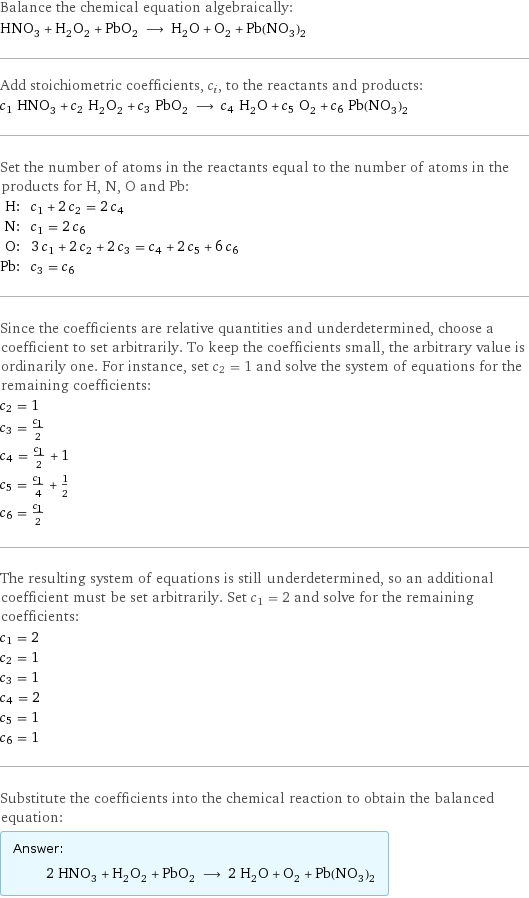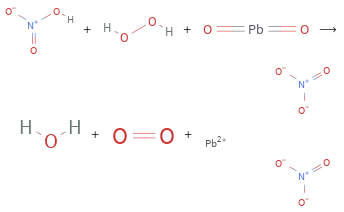Input interpretation

HNO_3 (nitric acid) + H_2O_2 (hydrogen peroxide) + PbO_2 (lead dioxide) ⟶ H_2O (water) + O_2 (oxygen) + Pb(NO_3)_2 (lead(II) nitrate)
Balanced equation

Balance the chemical equation algebraically: HNO_3 + H_2O_2 + PbO_2 ⟶ H_2O + O_2 + Pb(NO_3)_2 Add stoichiometric coefficients, c_i, to the reactants and products: c_1 HNO_3 + c_2 H_2O_2 + c_3 PbO_2 ⟶ c_4 H_2O + c_5 O_2 + c_6 Pb(NO_3)_2 Set the number of atoms in the reactants equal to the number of atoms in the products for H, N, O and Pb: H: | c_1 + 2 c_2 = 2 c_4 N: | c_1 = 2 c_6 O: | 3 c_1 + 2 c_2 + 2 c_3 = c_4 + 2 c_5 + 6 c_6 Pb: | c_3 = c_6 Since the coefficients are relative quantities and underdetermined, choose a coefficient to set arbitrarily. To keep the coefficients small, the arbitrary value is ordinarily one. For instance, set c_2 = 1 and solve the system of equations for the remaining coefficients: c_2 = 1 c_3 = c_1/2 c_4 = c_1/2 + 1 c_5 = c_1/4 + 1/2 c_6 = c_1/2 The resulting system of equations is still underdetermined, so an additional coefficient must be set arbitrarily. Set c_1 = 2 and solve for the remaining coefficients: c_1 = 2 c_2 = 1 c_3 = 1 c_4 = 2 c_5 = 1 c_6 = 1 Substitute the coefficients into the chemical reaction to obtain the balanced equation: Answer: | | 2 HNO_3 + H_2O_2 + PbO_2 ⟶ 2 H_2O + O_2 + Pb(NO_3)_2
Structures

+ + ⟶ + +
Names

nitric acid + hydrogen peroxide + lead dioxide ⟶ water + oxygen + lead(II) nitrate
Equilibrium constant
![K_c = ([H2O]^2 [O2] [Pb(NO3)2])/([HNO3]^2 [H2O2] [PbO2])](../image_source/3339613279dea603e1b6e41c46a871a3.png)
K_c = ([H2O]^2 [O2] [Pb(NO3)2])/([HNO3]^2 [H2O2] [PbO2])
Rate of reaction
![rate = -1/2 (Δ[HNO3])/(Δt) = -(Δ[H2O2])/(Δt) = -(Δ[PbO2])/(Δt) = 1/2 (Δ[H2O])/(Δt) = (Δ[O2])/(Δt) = (Δ[Pb(NO3)2])/(Δt) (assuming constant volume and no accumulation of intermediates or side products)](../image_source/b771a5b8ef1bfe11736415614cd9e48d.png)
rate = -1/2 (Δ[HNO3])/(Δt) = -(Δ[H2O2])/(Δt) = -(Δ[PbO2])/(Δt) = 1/2 (Δ[H2O])/(Δt) = (Δ[O2])/(Δt) = (Δ[Pb(NO3)2])/(Δt) (assuming constant volume and no accumulation of intermediates or side products)
Chemical names and formulas

| nitric acid | hydrogen peroxide | lead dioxide | water | oxygen | lead(II) nitrate formula | HNO_3 | H_2O_2 | PbO_2 | H_2O | O_2 | Pb(NO_3)_2 Hill formula | HNO_3 | H_2O_2 | O_2Pb | H_2O | O_2 | N_2O_6Pb name | nitric acid | hydrogen peroxide | lead dioxide | water | oxygen | lead(II) nitrate IUPAC name | nitric acid | hydrogen peroxide | | water | molecular oxygen | plumbous dinitrate
Substance properties

| nitric acid | hydrogen peroxide | lead dioxide | water | oxygen | lead(II) nitrate molar mass | 63.012 g/mol | 34.014 g/mol | 239.2 g/mol | 18.015 g/mol | 31.998 g/mol | 331.2 g/mol phase | liquid (at STP) | liquid (at STP) | solid (at STP) | liquid (at STP) | gas (at STP) | solid (at STP) melting point | -41.6 °C | -0.43 °C | 290 °C | 0 °C | -218 °C | 470 °C boiling point | 83 °C | 150.2 °C | | 99.9839 °C | -183 °C | density | 1.5129 g/cm^3 | 1.44 g/cm^3 | 9.58 g/cm^3 | 1 g/cm^3 | 0.001429 g/cm^3 (at 0 °C) | solubility in water | miscible | miscible | insoluble | | | surface tension | | 0.0804 N/m | | 0.0728 N/m | 0.01347 N/m | dynamic viscosity | 7.6×10^-4 Pa s (at 25 °C) | 0.001249 Pa s (at 20 °C) | | 8.9×10^-4 Pa s (at 25 °C) | 2.055×10^-5 Pa s (at 25 °C) | odor | | | | odorless | odorless | odorless
Units
